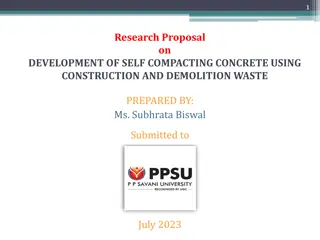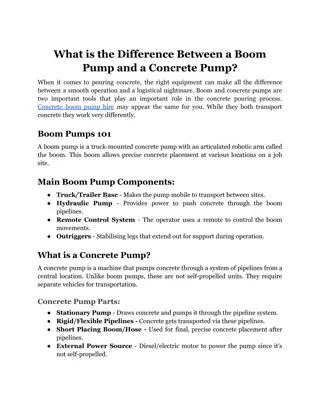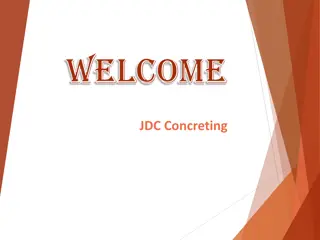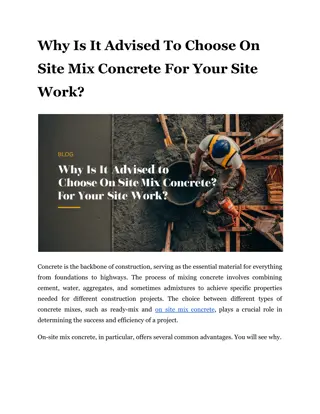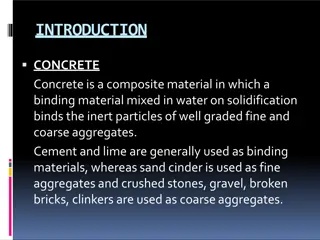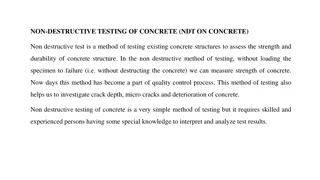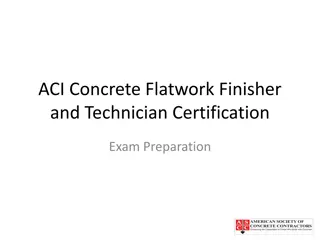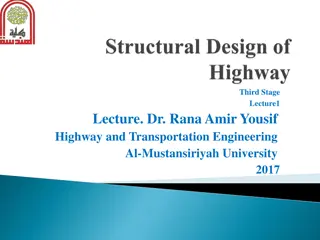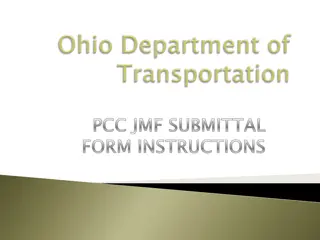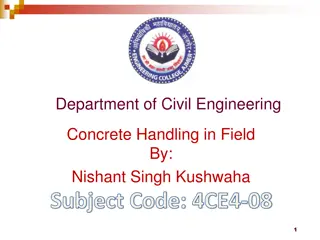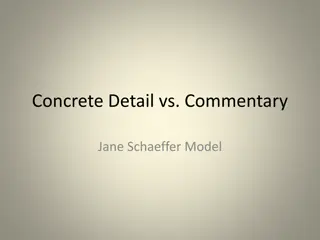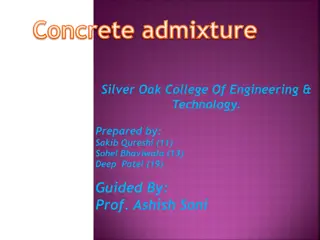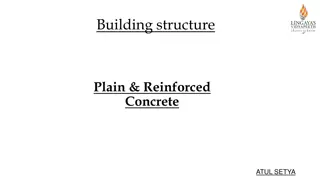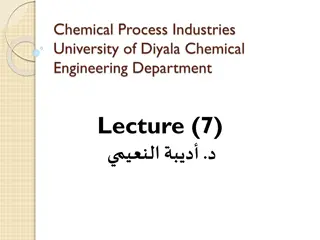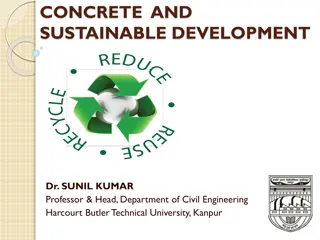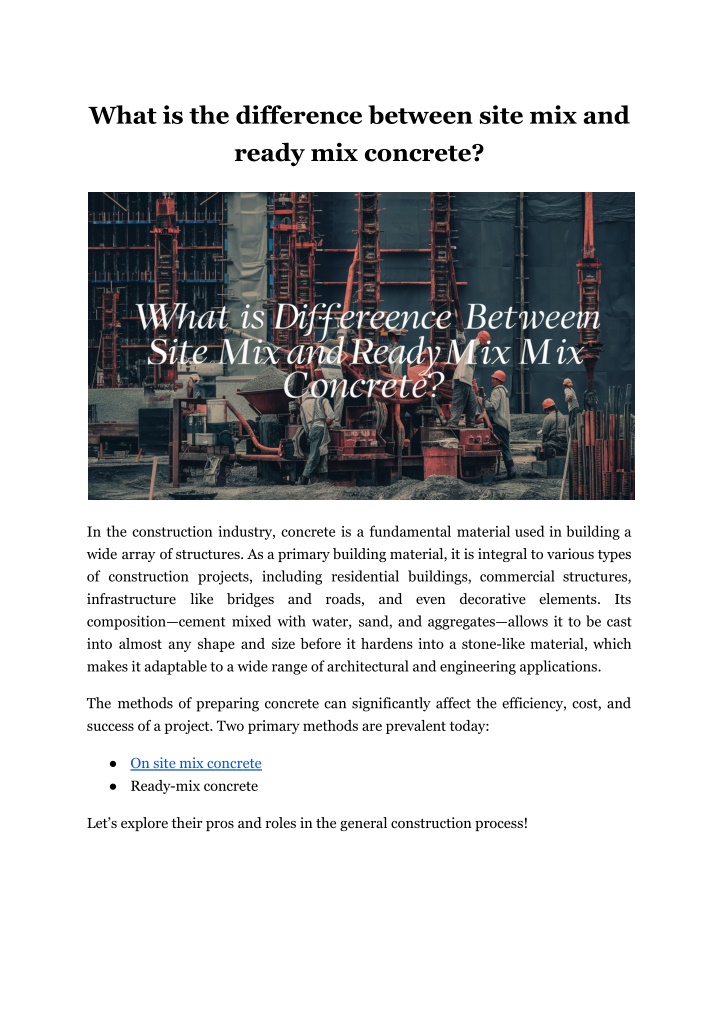
What is the difference between site mix and ready mix concrete
Ready mix concrete is batched and mixed at a central plant before being delivered tona construction site in mixer trucks. These trucks keep the concrete in motion tonprevent it from hardening before its application.
Download Presentation

Please find below an Image/Link to download the presentation.
The content on the website is provided AS IS for your information and personal use only. It may not be sold, licensed, or shared on other websites without obtaining consent from the author. If you encounter any issues during the download, it is possible that the publisher has removed the file from their server.
You are allowed to download the files provided on this website for personal or commercial use, subject to the condition that they are used lawfully. All files are the property of their respective owners.
The content on the website is provided AS IS for your information and personal use only. It may not be sold, licensed, or shared on other websites without obtaining consent from the author.
E N D
Presentation Transcript
What is the difference between site mix and ready mix concrete? In the construction industry, concrete is a fundamental material used in building a wide array of structures. As a primary building material, it is integral to various types of construction projects, including residential buildings, commercial structures, infrastructure like bridges and roads, composition cement mixed with water, sand, and aggregates allows it to be cast into almost any shape and size before it hardens into a stone-like material, which makes it adaptable to a wide range of architectural and engineering applications. and even decorative elements. Its The methods of preparing concrete can significantly affect the efficiency, cost, and success of a project. Two primary methods are prevalent today: On site mix concrete Ready-mix concrete Let s explore their pros and roles in the general construction process!
Concrete Mixing Approaches Concrete is essential for its strength and durability, but the quality and properties of concrete can vary greatly depending on how and where it is mixed. Understanding the distinctions between on-site mixed and ready-mixed concrete is crucial for contractors and builders to choose the optimal approach for their specific projects. Read More Articles: Exploring The Tissot Seastar 1000 Collection Watch What is On Site Mix Concrete? It involves the preparation of concrete at the actual construction site. This process uses portable mixers or mobile batching plants that are transported to the site, where all raw materials needed for the concrete are mixed as required. Advantages of On Site Mix Concrete Flexibility in Mixing: One of the primary benefits of on-site concrete mixing is the ability to adjust the mix according to immediate project needs. This flexibility allows for modifications in the mix if the construction conditions or specifications change. Freshness: Concrete mixed at the site is used immediately, ensuring that it hasn't begun to set or lose its optimal properties, which can occur with transport delays. Reduced Waste: Mixing exactly what is needed for a particular phase of the project helps in minimising waste, as there is no excess concrete that has been pre-mixed. Challenges with On-Site Mix Concrete Quality Control: Maintaining consistency in the concrete mix can be challenging as environmental factors and human error at the site can affect the mix. Requires Skilled Labour: Effective mixing and handling of concrete on-site demand experienced workers, which can increase labour costs. Storage of Materials: Large space is required to store the raw materials needed for mixing concrete, which can be a limitation on congested sites.
What is Ready Mix Concrete? Ready mix concrete is batched and mixed at a central plant before being delivered to a construction site in mixer trucks. These trucks keep the concrete in motion to prevent it from hardening before its application. Advantages of Ready Mix Concrete Consistency and Quality: Since the mixing is done in controlled environments and by professional ready-mix concrete suppliers, the batches are more consistent in quality compared to on-site mixed concrete. Reduced Labour and Equipment on Site: The need for on-site mixing equipment and labour is significantly reduced, streamlining operations and potentially lowering costs. Eco-Friendly: Centralised mixing helps reduce dust and noise pollution at the site, which is beneficial in urban settings or environmentally sensitive zones. Struggles with Ready-Mix Concrete Logistical Requirements: The need for timely deliveries can create logistical challenges, especially in areas with heavy traffic or remote locations. Initial Set-up Costs: Although it reduces labour costs, the initial expense involved in setting up or contracting with a supplier can be high. Role of Ready Mix Concrete Suppliers Ready-mix concrete suppliers play a crucial role in ensuring the availability of high-quality concrete. They not only provide the necessary materials but also expertise in the optimal compositions of mixes for different types of construction needs. Their services include: Custom Mix Designs: Suppliers can create specific mixes to enhance the strength, durability, or other required characteristics of the concrete based on contractor specifications. Technical Support and Consultation: Suppliers often offer expert advice on concrete application techniques and solutions to potential problems encountered on-site.
Efficiency in Supply Chain: Established suppliers have efficient systems for order fulfilment, which ensures that concrete is delivered as needed, minimising delays and disruptions in the construction schedule. Read More Articles: How do private charter flights departing from Austin provide enhanced convenience, privacy, and comfort compared to commercial airline options? Choosing Between On-Site Mix Concrete and Ready Mix Concrete The choice between on-site mixed concrete and ready-mix concrete depends on various factors, including project size, timeline, cost, and quality requirements. For large-scale projects that require high volumes of concrete where consistency and efficiency are paramount, ready-mix is often the preferred choice. It is particularly suitable for projects with tight deadlines, as it can be delivered continuously to the site, allowing for faster progression of construction activities. On the other hand, on-site mix concrete may be more appropriate for smaller projects or when the construction site is in a remote location where timely delivery of ready mix concrete may be challenging. It is also ideal for projects that require different types of concrete mixes or when there is uncertainty about the exact amount of concrete needed. Conclusion The choice between on-site mix concrete and ready-mix concrete depends on various factors including project size, location, quality requirements, and available resources. While on-site mix offers flexibility and freshness, ready mix ensures consistency, quality, and convenience. Each method has its merits and can be selected based on the specific needs and circumstances of the construction project. And, you can get both types at Pro-Mix Concrete! Site Article: What is the difference between site mix and ready mix concrete

